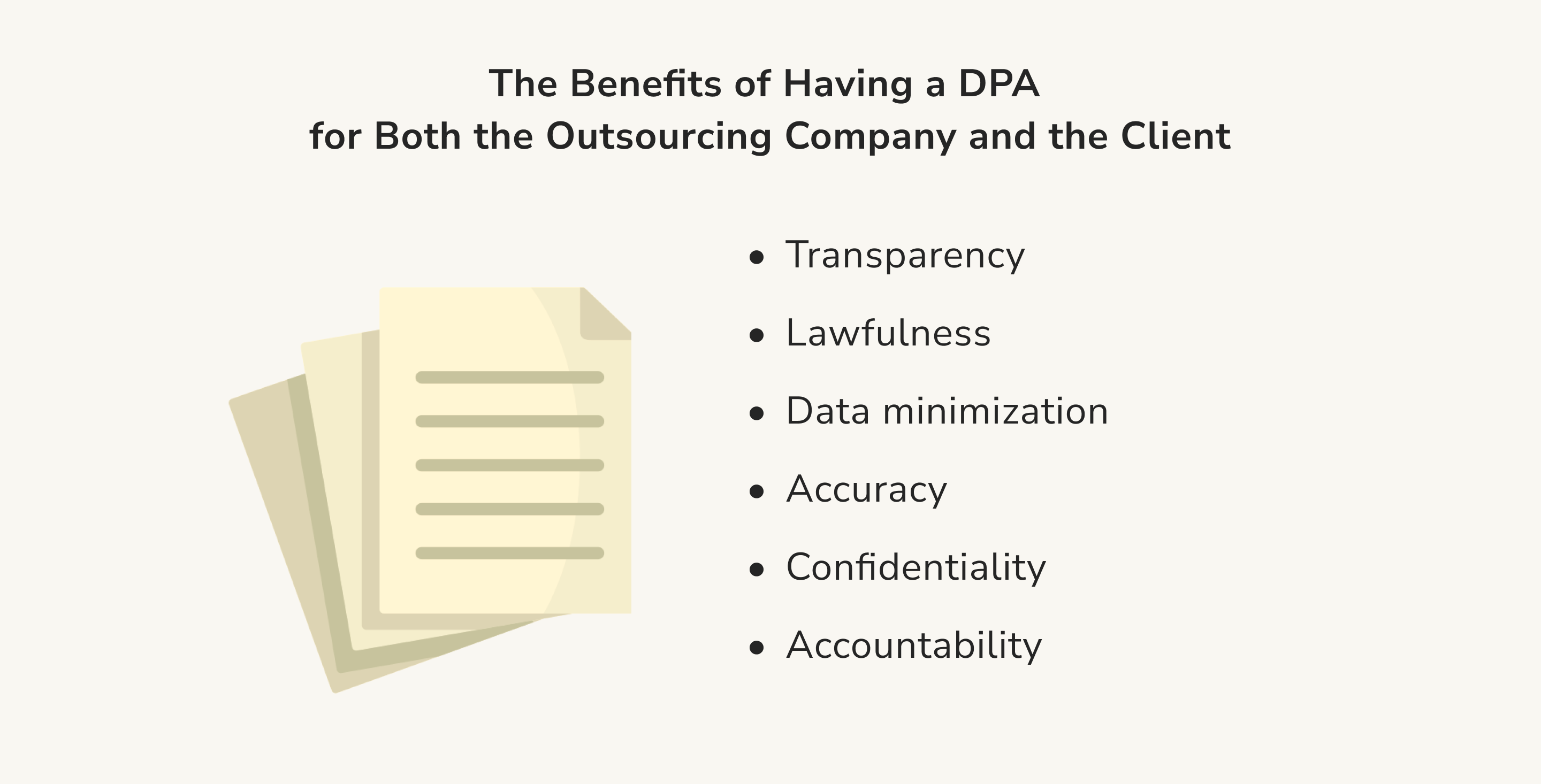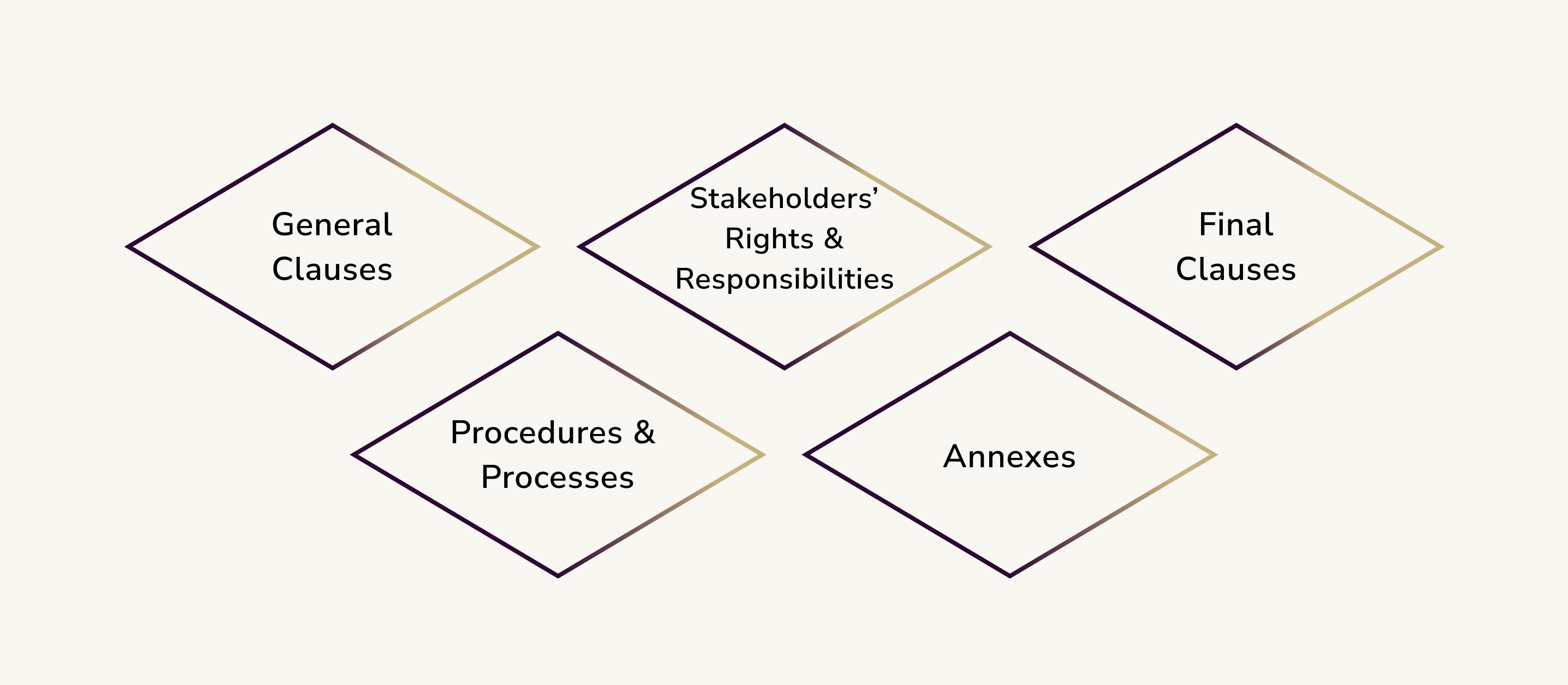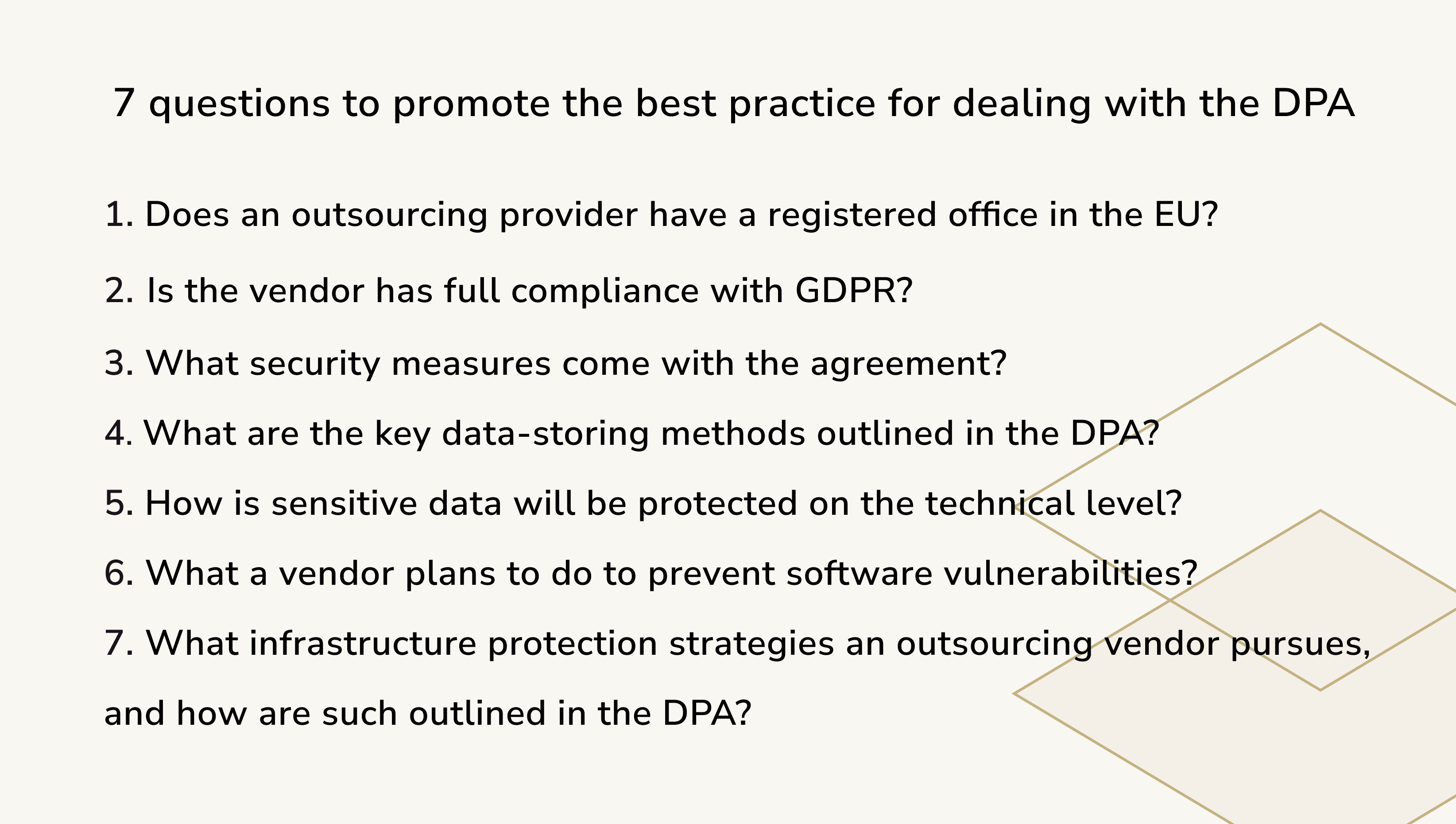Data Processing Agreement (DPA) In Software Development Outsourcing

With the software development outsourcing market anticipated to reach a staggering $684 billion by 2027, many companies are tapping into the phenomenon. In turn, trying to harness the power of outsourcing and trying to make it more secure, nations are coming up with different standards and regulations guiding the roles and responsibilities of parties involved in software development service delivery.
Keeping this in mind, in 2018, the European Union enforced the General Data Protection Regulation (GDPR) to improve the protection of personal data used in the digital realm. In such a case, one of the major components of GDPR is a Data Processing Agreement (DPA) signed between the parties handling the data.
Now, let’s take a closer look at DPA, determine its purpose and provisions, and investigate why software development outsourcing companies need it. Besides, it is crucial to illustrate what a general DPA looks like and provide some tips for making the DPA that will deliver the expected results.
What is a DPA?
To understand what the DPA is, one should focus on several key aspects. First, we explore what DPA stands for. Then, we investigate the DPA’s key provisions. Finally, one should understand how the DPA differs from standard contracts or terms of service used in software development outsourcing. So, without further ado, let’s proceed to deconstruct DPA to have a better understanding of the phenomenon.
DPA’s Definition and Purpose
What is a DPA? As you might have guessed, DPA stands for Data Processing Agreement. In a nutshell, the DPA is a legal document signed by two parties, the controller and the processor. It is written in an electronic form and is bound to regulate all the terms, conditions, and processes linked to the EU citizens’ data processing. One should note that personal data is presented as any type of information one can use to identify a certain individual.
The key purpose of the DPA is threefold:
- Establish the scope of data processing activities.
- Determine what data is processed and how it should be protected.
- Create a relationship between the controller and the processor in the above context.
Keeping all these aspects in mind, the DPA guarantees that the software development outsourcing process has enough data protection to ensure people using the product are secured against data breaches and other aspects that can thwart their personal information.

Key DPA Provisions
Another important aspect of the Data Processing Agreement is its primary provisions. These are the key elements that each DPA should have:
- The established purpose and objective of using personal data during and after software development.
- The particular types of personal data will be used in any given manner.
- The overall duration of the DPA considers all the stages of software development.
- The well-defined roles and obligations of each party involved in the DPA.
- The rights of individuals per their personal data being used.
- The designed security measures as a response to the DPA violation.
- The particular use of all the sub-processors and their obligations.
- The overall obligations on given data transfers,
- The liability of the data controller, data processor, and sub-processors.
- The measures taken to ensure top-grade protection of user data.
The elements above wrap the essence of the DPA and show in what particular directions the parties involved should move. Following the provisions ensure you have a proper DPA on your hands. Now, let’s determine how DPA differs from a standard contract or terms of service.
How Does DPA Differ from a Standard Contract or Terms of Service
In short, the DPA comes with a data controller and data processor.
- Data controller. This party is the one sharing data. In software development outsourcing, a data controller is a client or a product’s owner.
- Data processor. This party is the one processing the data shared. It can be a person or an entire company. In software development outsourcing, it is a contractor or a vendor developing the product.
One of the unique aspects of the DPA is linked to the signing of a GDPR data processing agreement on behalf of both a data controller and a data processor. Essentially, there is a major difference in responsibilities with signing.
For data controllers, the process entails the following:
- Data transfer.
- Provision of instructions on conducting operations with every aspect of personal data outlined in the project.
- Verify that the given document does not surpass the existing legal boundaries.
- Examine the way in which a data processor will use the user’s personal data.
In such a case, it is crucial to indicate that in the DPA, the data controller is fully responsible for data breaches. This is unique to the Data Processing Agreement GDPR compared to standard contracts. At this point, the data controller should pay particular attention to preparing the document with well-established and clear instructions.
For data processors, the process entails the following:
- Provision of secure data processing services.
- Following the guidelines outlined by a data controller.
- Handling data only after the DPA is signed.
- Notifying the data controller in the scenario of some data breach or incident taking place.
- Engaging sub-processors only if this is verified by the DPA.
Keeping all these aspects in mind, DPA data protection differs from standard contracts or terms of services because of the differences in the data controller and data processor’s responsibilities and the way both parties approach the DPA signing.
Why Do Software Development Outsourcing Companies Need a Data Processing Agreement?
From the insights above, you might have figured out that the DPA predominantly regulates how parties involved in software development manage users’ personal data during and after developing the software product.
Yet, this is a general overview. To understand more comprehensively, let’s explore some key reasons Data Processing Agreement has been used in software development outsourcing.
The Risks of Data Breaches and Data Misuse in Software Development Outsourcing
It is apparent that there is no single company that is a hundred percent bulletproof from data breaches. However, the damage from such an occurrence is directly proportional to the effectiveness of the response. Keeping that in mind, if a data breach occurs, the parties involved know what to do and how to do that.
Essentially, if there is a data breach, it is vital to notify the authorities within a seventy-hour period. If the breach presents a high degree of risk to users, one should also notify those affected by the breach. At this point, the DPA provides strict guidelines for what data controllers and processors should do when a data breach occurs.
The Legal and Regulatory Requirements for Data Protection in Software Development Outsourcing
Data Processing Agreement requirements include various legal and regulatory aspects linked to data protection. In other words, the key reason behind the DPA is to follow the mandatory regulatory requirements presented by GDPR and other documents focusing on data protection.
Keeping that in mind, following the DPA is crucial for meeting the existing data protection requirements. Otherwise, you will face massive penalties and fines if there is no adherence to data protection standards existing within a particular nation or territory. Overall, regarding legal and regulatory requirements to apply in software outsourcing and relying on the DPA, the following is worth mentioning:
- Technical data processing.
- Data backing service regardless of whether it is stored in the cloud or physical servers.
- Data collection via an external service provider.
- Disposal of hardware containing sensitive data.
These are legal and regulatory requirements to follow. And this is one of the key reasons the DPA is used in software outsourcing. Putting this aspect behind, it is important to explore the benefits for the outsourcing company and the client linked to having a DPA.
The Benefits of Having a DPA for Both the Outsourcing Company and the Client
Overall, the key benefit of DPA from both data controller and data processor in software outsourcing is that the document ensures the top-notch reliability and quality of the data processing actions.

The secondary benefits of DPA in software outsourcing are the following:
- Transparency. The DPA clearly describes how data should be managed and processed. This offers a high level of transparency in the software outsourcing process.
- Lawfulness. The DPA clearly indicates whether you follow the existing rules and regulations. In such a case, you avoid fines related to noncompliance.
- Data minimization. The DPA depicts what particular data you need within the software development process. It allows using data more efficiently and effectively.
- Accuracy. The DPA aids software outsourcing by improving data accuracy. The more parties know how to manage users’ data, the greater the accuracy of data management.
- Confidentiality. The DPA offers clear provisions for preserving users’ confidentiality by following the requirements outlined in EU DPA and similar documents.
- Accountability. The DPA outlines who will be responsible for noncompliance and potential data breach.
With the benefits above, it is clear the DPA makes data management involved in software outsourcing more secure and accurate. At this point, tap into what the document offers; you must follow DPA laws precisely.
What Should a Typical Data Processing Agreement Include?
What is in a Data Processing Agreement? Data Processing Agreements generally include five key elements:

General Clauses
This element is about naming a data controller and a data processor. The first party is presented as a stakeholder entrusting their data to a third party. The second party is processing data on behalf of the data controller.
In addition, the general clauses describe different types of DPA data along with the subjects of data. The latter often includes categories of users whose data will be processed.
Going further, the general clauses entail these aspects:
- Data processing goals
- Customer data scope
- DPA software used
- Data processing duration
- Data storage description
- The DPA duration
- Conditions of agreement termination
The final aspect included in general clauses correlates to the fact personal data should be removed after a data controller and a data processor finished using it. Every inch of users’ personal data should be deleted permanently.
Stakeholders’ Rights and Responsibilities
This element entails two segments. The first one is about the rights and responsibilities of a data controller. The second one is about the rights and responsibilities of a data processor.
When speaking about the controller, the key is to object to the given rights of data subjects and ensure the data processor manages data with compliance, instruments, and regulations.
In turn, for a processor, this DPA element describes what a data processor should do. The key duty is to provide data security and eliminate all potential data breach risks. In addition, the rights and responsibilities of a data processor include preparing a potential data breach response.
Procedures and Processes
The third segment corresponds to a third party devoted to ensuring data protection and secure data processing in software outsourcing. In such a case, you must consider these aspects:
- Organizational part. This element focuses on data protection and agreement compliance
- Technical part. This element focuses on all the technical aspects linked to data processing.
Keeping the aspects above in mind, it is crucial to include all the organizational and technical elements that come with Data Processing Agreement. At this point, have procedures and processes outlined and clearly defined. Otherwise, you will face issues following the key procedures under the DPA.
Final clauses
Regarding final clauses; these elements should be included in the DPA:
- Primary conditions under which the DPA cannot be changed.
- Data Processing Agreement superiority over other documents included in the software outsourcing process.
Respectively, the final clauses show all the conditions that make the agreement unchanged. Otherwise, if there are no such conditions in the agreement, you might not be able to anticipate how other parties involved change the preliminary and primary agreement’s clauses.
Annexes
Finally, the DPA should typically include various annexes. These include the following:
- Tables. These annexes illustrate step-by-step process descriptions.
- Audits. These annexes entail the audit results and insights from these.
- GDPR sections. These annexes include lists of various GDPR sections illustrating various parts of the document linked to the DPA.
With the sections above covered, you now have a DPA you can use in software development outsourcing. In such a case, the next important step is to discover some tips in the DPA government agreement, common mistakes to avoid when dealing with the DPA, and best practices for implementing a DPA example.
How to Draft a Data Processing Agreement for Software Development Outsourcing
Drafting a good DPA depends on several factors. The first was about investigating the crucial elements you need to include in the DPA. Next, looking at some notable tips for negotiating a DPA with an outsourcing provider is important.
Tips for Negotiating a DPA with an Outsourcing Provider
In a nutshell, there are five tips we can give you to draft and negotiate a great DPA example. At this point, here are the aspects to consider:
- Finding the outsourcing provider you can trust. The first tip in negotiating the DPA is all about finding the right partner you can negotiate with in the first place. This entails reviewing the provider’s portfolio, expertise, and team composition. Besides, look for prior links to data breaches or litigation. If the prospective partner has a good reputation, there is a good chance you won’t have trouble negotiating the DPA with them.
- Checking the provider for a DPA template. Check whether your outsourcing provider understands what DPA is. To do that, pay attention to the DPA document template. It means you give them the template first and look at how they handle it. You can proceed to the next steps if they know their way around DPA.
- Reviewing provider’s data processing capabilities and security practices in place. After you have selected the partner and they passed the template test, it is time to review how the provider handles data processing and what security practices they use to safeguard the process. In such a case, there are two ways to do that. First, conduct a tech review with the partner’s tech experts. Second, review their prior projects and drive necessary conclusions from that.
- Signing the DPA agreement. If all prior stages are a go, it is time to sign the DPA. There is nothing challenging about this phase. However, don’t forget to print out at least two companies.
- The rest is history. So, is a Data Processing Agreement required? Of course. If you have found the right partner, they will handle the rest. Ideally, a knowledgeable and reputable software provider will implement the DPA without asking you for any degree of involvement.
Follow the tips above and find a partner knowing their way around the DPA. If you make it happen, there is a high chance your product will be in good hands, and security breaches won’t happen. Now, let’s look at some common mistakes to avoid when drafting the DPA.
Common Mistakes to Avoid when Drafting a DPA
In general, when working with the DPA, one can commit six common mistakes. It is time to explore them in greater detail.
- The data processor and data controller are not properly identified in the agreement.
- There is no clear purpose of the agreement, meaning there are no apparent indications of which data will be used and for what reasons.
- The obligations of each party involved are not clearly defined.
- There is no well-established duration of the agreement to protect the parties involved.
- The terms of confidentiality are absent or not clearly defined, which thwarts the sensitive data used in the process.
- Any applicable laws and regulations are not mentioned in the agreement.
Keep a close eye on the common mistakes above, and you will see how your DPA will soon become a document that protects sensitive information and ensures both the data controller and data processor know their roles and responsibilities.
Best Practices for Implementing and Enforcing a DPA
Finally, it is time to determine some key practices for implementing and enforcing the DPA. In a nutshell, you need to ask some key questions to do that. Here are seven questions to promote the best practice for dealing with the DPA:
- Does an outsourcing provider have a registered office in the EU? This question is important for having a DPA with legal value with a chosen outsourcing provider.
- Is the vendor has full compliance with GDPR? Even if you, the selected outsourcing provider, comply with the DPA, it does not mean they comply with GDPR.
- What security measures come with the agreement? Implementing the DPA stands on the security measures a data process comes with. Make sure your provider illustrates how they will protect sensitive data.
- What are the key data-storing methods outlined in the DPA? Proper data storage is at the forefront of protecting information from data breaches. The DPA should have this clearly defined.
- How is sensitive data will be protected on the technical level? To implement the DPA properly, you need to ask the provider to illustrate the data protection measures on the technical level. For instance, whether the data is handled on-site or in-cloud.
- What a vendor plans to do to prevent software vulnerabilities? Another important aspect of enforcing the DPA is looking at how a data processor will prevent software vulnerabilities.
- What infrastructure protection strategies an outsourcing vendor pursues, and how are such outlined in the DPA? Finally, clear infrastructure protection strategies should be presented to implement the DPA granting full data protection.

Let the questions above guide the implementation and enforcement of the DPA making software outsourcing effective and secure. Remember that the more you prepare, the fewer obstacles you will face later.
Conclusion
The Data Processing Agreement is a crucial part of GDPR. It stands for data protection on the part of the data controller and the data processor to ensure users’ information is securely stored and handled. Use the insights above to design, adopt, and implement the best DPA possible. It is vital to deal with the DPA at the early stages, namely because if you face noncompliance or data breaches later on, it will cost you more than you can afford.

Roman Zomko
Other articles